三字经英文版-赵彦春
- 格式:docx
- 大小:47.81 KB
- 文档页数:37
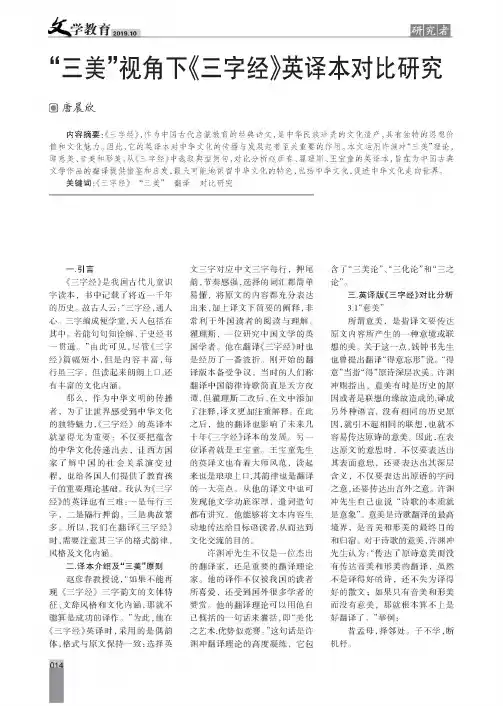
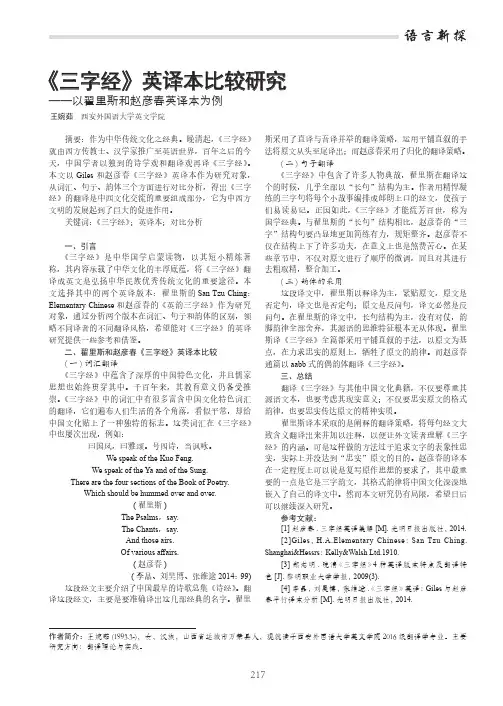
语言新探《三字经》英译本比较研究——以翟里斯和赵彦春英译本为例王婉茹 西安外国语大学英文学院摘要:作为中华传统文化之经典。
晚清起,《三字经》就由西方传教士、汉学家推广至英语世界,百年之后的今天,中国学者以独到的诗学观和翻译观再译《三字经》。
本文以 Giles 和赵彦春《三字经》英译本作为研究对象,从词汇、句子、韵体三个方面进行对比分析,得出《三字经》的翻译是中西文化交流的重要组成部分,它为中西方文明的发展起到了巨大的促进作用。
关键词:《三字经》;英译本;对比分析一、引言《三字经》是中华国学启蒙读物,以其短小精炼著称,其内容承载了中华文化的丰厚底蕴,将《三字经》翻译成英文是弘扬中华民族优秀传统文化的重要途径。
本文选择其中的两个英译版本:翟里斯的San Tzu Ching:Elementary Chinese和赵彦春的《英韵三字经》作为研究对象,通过分析两个版本在词汇、句子和韵体的区别,领略不同译者的不同翻译风格,希望能对《三字经》的英译研究提供一些参考和借鉴。
二、翟里斯和赵彦春《三字经》英译本比较(一)词汇翻译《三字经》中蕴含了深厚的中国特色文化,并且儒家思想也始终贯穿其中。
千百年来,其教育意义仍备受推崇。
《三字经》中的词汇中有很多富含中国文化特色词汇的翻译,它们遍布人们生活的各个角落,看似平常,却给中国文化贴上了一种独特的标志。
这类词汇在《三字经》中也屡次出现,例如:曰国风,曰雅颂。
号四诗,当讽咏。
We speak of the Kuo Feng.We speak of the Ya and of the Sung.There are the four sections of the Book of Poetry.Which should be hummed over and over.(翟里斯)The Psalms,say.The Chants,say.And those airs.Of various aff airs.(赵彦春)(李晶、刘昊博、张维途 2014:99)这段经文主要介绍了中国最早的诗歌总集《诗经》。
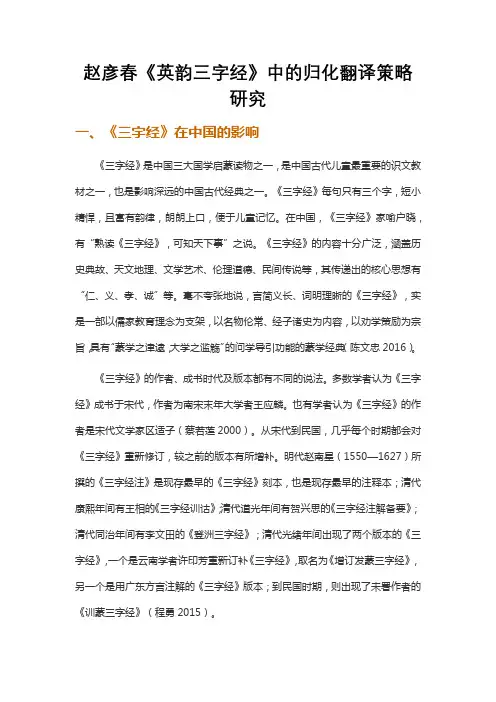
赵彦春《英韵三字经》中的归化翻译策略研究一、《三字经》在中国的影响《三字经》是中国三大国学启蒙读物之一,是中国古代儿童最重要的识文教材之一,也是影响深远的中国古代经典之一。
《三字经》每句只有三个字,短小精悍,且富有韵律,朗朗上口,便于儿童记忆。
在中国,《三字经》家喻户晓,有“熟读《三字经》,可知天下事”之说。
《三字经》的内容十分广泛,涵盖历史典故、天文地理、文学艺术、伦理道德、民间传说等,其传递出的核心思想有“仁、义、孝、诚”等。
毫不夸张地说,言简义长、词明理晰的《三字经》,实是一部以儒家教育理念为支架,以名物伦常、经子诸史为内容,以劝学策励为宗旨,具有“蒙学之津逮,大学之滥觞”的问学导引功能的蒙学经典(陈文忠2016)。
《三字经》的作者、成书时代及版本都有不同的说法。
多数学者认为《三字经》成书于宋代,作者为南宋末年大学者王应麟。
也有学者认为《三字经》的作者是宋代文学家区适子(蔡若莲2000)。
从宋代到民国,几乎每个时期都会对《三字经》重新修订,较之前的版本有所增补。
明代赵南星(1550—1627)所撰的《三字经注》是现存最早的《三字经》刻本,也是现存最早的注释本;清代康熙年间有王相的《三字经训诂》;清代道光年间有贺兴思的《三字经注解备要》;清代同治年间有李文田的《登洲三字经》;清代光绪年间出现了两个版本的《三字经》,一个是云南学者许印芳重新订补《三字经》,取名为《增订发蒙三字经》,另一个是用广东方言注解的《三字经》版本;到民国时期,则出现了未署作者的《训蒙三字经》(程勇2015)。
虽然关于《三字经》的作者和成书时代并无定论,且每个时期又有不同的增订版本,但这正充分体现出《三字经》的价值所在。
正因为《三字经》的思想价值和文化魅力广为世人所接受,才会出现那么多研究《三字经》的优秀学者。
他们根据前人所著,重新对《三字经》进行内容上的补充和注释,增加一些历史故事,传递出更多故事中包含的为人做事的道理,这是《三字经》的一大特点。
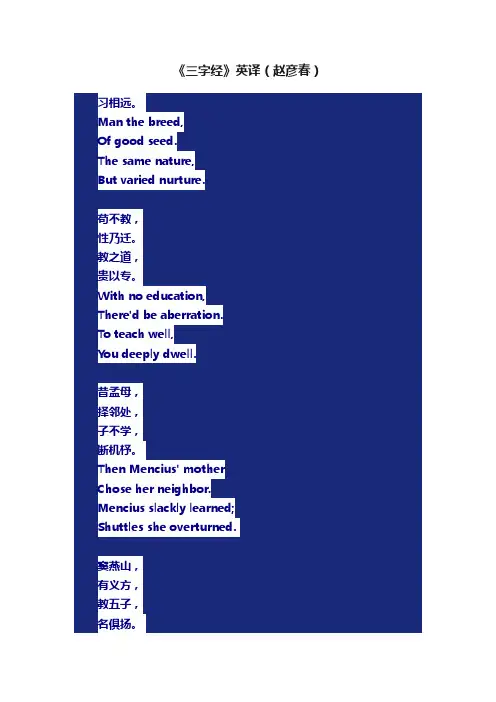
《三字经》英译(赵彦春)习相远。
Man the breed,Of good seed.The same nature,But varied nurture.苟不教,性乃迁。
教之道,贵以专。
With no education,There'd be aberration.To teach well,You deeply dwell.昔孟母,择邻处,子不学,断机杼。
Then Mencius' motherChose her neighbor.Mencius slackly learned;Shuttles she overturned.窦燕山,有义方,教五子,名俱扬。
Dough, as hight, Managed so right.His five sons Became famous ones.养不教,父之过。
教不严,师之惰。
What's a father?A good teacher.What's a teacher?A strict preacher.子不学,非所宜。
幼不学,老何为?An unschooled child Will grow wild.A poor-learning youth, Will turn uncouth.玉不琢,不成器。
人不学,不知义。
The crude jadeIsn't finely made;Not learning right,One'll virtues slight.为人子,方少时,亲师友,习礼仪。
Son of man,Mature you can. Models you requite, Learn the rite.香九龄,能温席。
孝于亲,所当执。
Xiang, at nine, Warmed bedding fine. Follow this one,This filial son.融四岁,能让梨。
弟于长,宜先知。
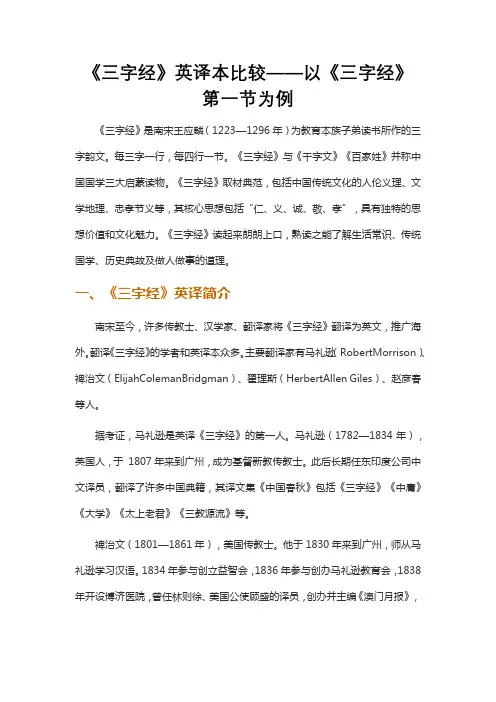
《三字经》英译本比较——以《三字经》第一节为例《三字经》是南宋王应麟(1223—1296年)为教育本族子弟读书所作的三字韵文。
每三字一行,每四行一节。
《三字经》与《千字文》《百家姓》并称中国国学三大启蒙读物。
《三字经》取材典范,包括中国传统文化的人伦义理、文学地理、忠孝节义等,其核心思想包括“仁、义、诚、敬、孝”,具有独特的思想价值和文化魅力。
《三字经》读起来朗朗上口,熟读之能了解生活常识、传统国学、历史典故及做人做事的道理。
一、《三字经》英译简介南宋至今,许多传教士、汉学家、翻译家将《三字经》翻译为英文,推广海外。
翻译《三字经》的学者和英译本众多。
主要翻译家有马礼逊(RobertMorrison)、裨治文(ElijahColemanBridgman)、翟理斯(HerbertAllen Giles)、赵彦春等人。
据考证,马礼逊是英译《三字经》的第一人。
马礼逊(1782—1834年),英国人,于1807年来到广州,成为基督新教传教士。
此后长期任东印度公司中文译员,翻译了许多中国典籍,其译文集《中国春秋》包括《三字经》《中庸》《大学》《太上老君》《三教源流》等。
裨治文(1801—1861年),美国传教士。
他于1830年来到广州,师从马礼逊学习汉语。
1834年参与创立益智会,1836年参与创办马礼逊教育会,1838年开设博济医院,曾任林则徐、美国公使顾盛的译员,创办并主编《澳门月报》,晚年主要从事《新旧约全书》新译工作,1861年在上海去世。
裨治文在《澳门月报》上发表了《三字经》英译本。
翟理斯(1845—1935年),英国外交官、汉学家,1867年来到中国,任英国驻华使馆翻译,1897年当选剑桥大学第二任汉学教授。
翟理斯在汉学研究领域成绩显著,善于将韵律和词义巧妙结合,一生翻译了较多中国典籍,其中包括《三字经》。
翟理斯《三字经》英译本采用英汉对照编排方式,给每个汉字注音,并对其偏旁、部首、结构进行分析。
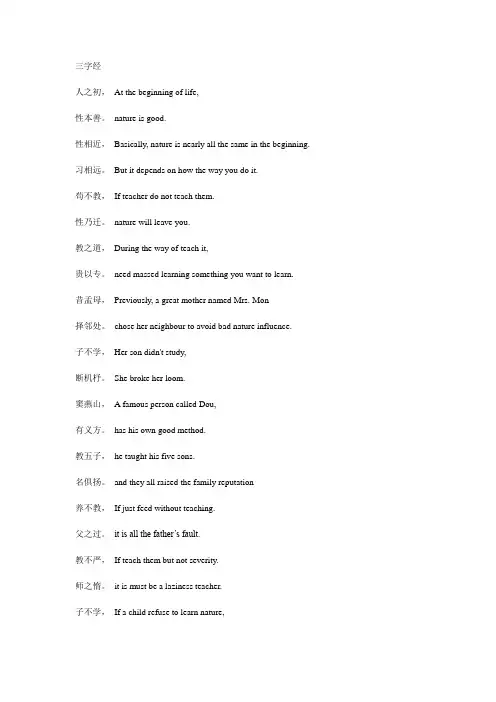
三字经人之初,At the beginning of life,性本善。
nature is good.性相近,Basically, nature is nearly all the same in the beginning. 习相远。
But it depends on how the way you do it.苟不教,If teacher do not teach them.性乃迁。
nature will leave you.教之道,During the way of teach it,贵以专。
need massed learning something you want to learn.昔孟母,Previously, a great mother named Mrs. Mon择邻处。
chose her neighbour to avoid bad nature influence.子不学,Her son didn't study,断机杼。
She broke her loom.窦燕山,A famous person called Dou,有义方。
has his own good method.教五子,he taught his five sons.名俱扬。
and they all raised the family reputation养不教,If just feed without teaching.父之过。
it is all the father’s fault.教不严,If teach them but not severity.师之惰。
it is must be a laziness teacher.子不学,If a child refuse to learn nature,非所宜。
that should be not good for the child .幼不学,If a child doesn't learn something in childhood, 老何为。
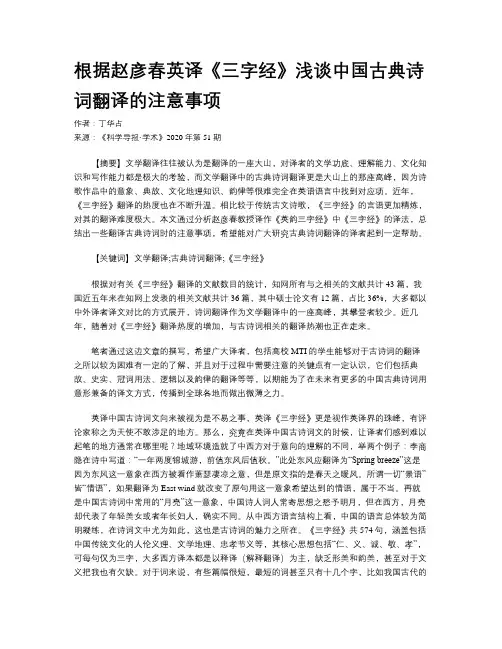
根据赵彦春英译《三字经》浅谈中国古典诗词翻译的注意事项作者:丁华占来源:《科学导报·学术》2020年第51期【摘要】文学翻译往往被认为是翻译的一座大山,对译者的文学功底、理解能力、文化知识和写作能力都是极大的考验,而文学翻译中的古典诗词翻译更是大山上的那座高峰,因为诗歌作品中的意象、典故、文化地理知识、韵律等很难完全在英语语言中找到对应项。
近年,《三字经》翻译的热度也在不断升温。
相比较于传统古文诗歌,《三字经》的言语更加精炼,对其的翻译难度极大。
本文通过分析赵彦春教授译作《英韵三字经》中《三字经》的译法,总结出一些翻译古典诗词时的注意事项,希望能对广大研究古典诗词翻译的译者起到一定帮助。
【关键词】文学翻译;古典诗词翻译;《三字经》根据对有关《三字经》翻译的文献数目的统计,知网所有与之相关的文献共计43篇,我国近五年来在知网上发表的相关文献共计36篇,其中硕士论文有12篇,占比36%,大多都以中外译者译文对比的方式展开,诗词翻译作为文学翻译中的一座高峰,其攀登者较少。
近几年,随着对《三字经》翻译热度的增加,与古诗词相关的翻译热潮也正在走来。
笔者通过这边文章的撰写,希望广大译者,包括高校MTI的学生能够对于古诗词的翻译之所以较为困难有一定的了解,并且对于过程中需要注意的关键点有一定认识,它们包括典故、史实、冠词用法、逻辑以及韵律的翻译等等,以期能为了在未来有更多的中国古典诗词用意形兼备的译文方式,传播到全球各地而做出微薄之力。
英译中国古诗词文向来被视为是不易之事,英译《三字经》更是视作英译界的珠峰,有评论家称之为天使不敢涉足的地方。
那么,究竟在英译中国古诗词文的时候,让译者们感到难以起笔的地方通常在哪里呢?地域环境造就了中西方对于意向的理解的不同,举两个例子:李商隐在诗中写道:“一年两度锦城游,前值东风后值秋。
”此处东风应翻译为“Spring breeze”这是因为东风这一意象在西方被看作萧瑟凄凉之意,但是原文指的是春天之暖风。
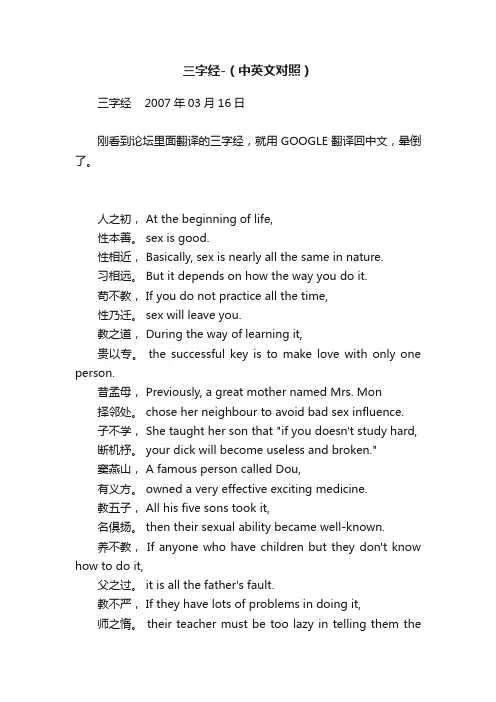
三字经-(中英文对照)三字经 2007年03月16日刚看到论坛里面翻译的三字经,就用GOOGLE翻译回中文,晕倒了。
人之初, At the beginning of life,性本善。
sex is good.性相近, Basically, sex is nearly all the same in nature.习相远。
But it depends on how the way you do it.苟不教, If you do not practice all the time,性乃迁。
sex will leave you.教之道, During the way of learning it,贵以专。
the successful key is to make love with only one person.昔孟母, Previously, a great mother named Mrs. Mon择邻处。
chose her neighbour to avoid bad sex influence.子不学, She taught her son that "if you doesn't study hard, 断机杼。
your dick will become useless and broken."窦燕山, A famous person called Dou,有义方。
owned a very effective exciting medicine.教五子, All his five sons took it,名俱扬。
then their sexual ability became well-known.养不教, If anyone who have children but they don't know how to do it,父之过。
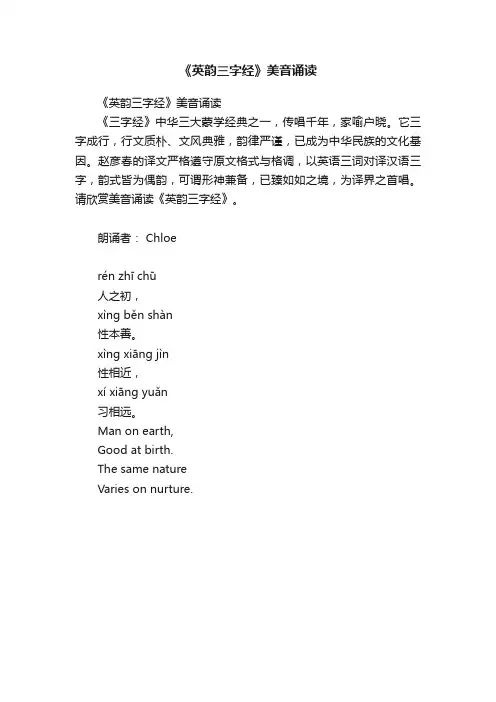
《英韵三字经》美音诵读《英韵三字经》美音诵读《三字经》中华三大蒙学经典之一,传唱千年,家喻户晓。
它三字成行,行文质朴、文风典雅,韵律严谨,已成为中华民族的文化基因。
赵彦春的译文严格遵守原文格式与格调,以英语三词对译汉语三字,韵式皆为偶韵,可谓形神兼备,已臻如如之境,为译界之首唱。
请欣赏美音诵读《英韵三字经》。
朗诵者: Chloerén zhī chū人之初,xìng běn shàn性本善。
xìng xiāng jìn性相近,xí xiāng yuǎn习相远。
Man on earth,Good at birth.The same natureVaries on nurture.(2)gǒu bù jiāo苟不教,xìng nǎi qiān性乃迁。
jiāo zhī dào教之道,guì yǐ zhuān贵以专。
With no education, There’d be aberration. To teach well,You deeply dwell.(3)xī mèng mǔ昔孟母,zé lín chù择邻处zǐ bù xué子不学,duàn jī zhù断机杼。
Then Mencius’ mother Chose her neighbor.At Mencius’ sloth, She cut th’ cloth.(4)dòu yàn shān窦燕山,yǒu yì fāng有义方,jiāo wǔ zǐ教五子,míng jù yáng名俱扬。
Dough by name Fulfilled his aim.His five sons Became famous ones.(5)yǎng bù jiāo养不教,fù zhī guò父之过。
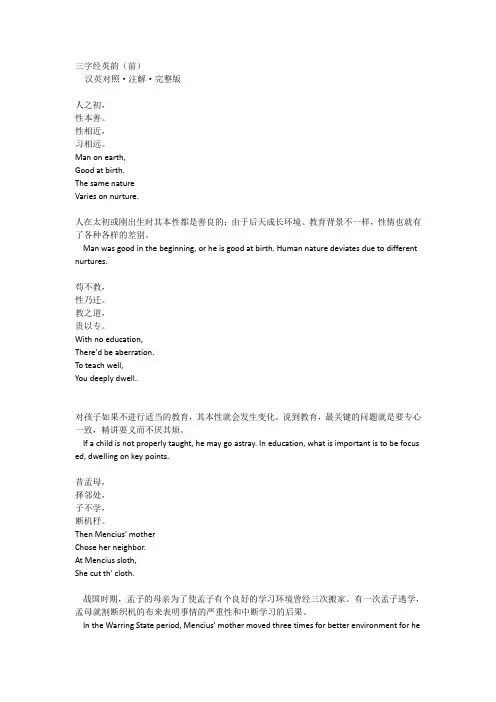
三字经英韵(前)汉英对照·注解·完整版人之初,性本善。
性相近,习相远。
Man on earth,Good at birth.The same natureVaries on nurture.人在太初或刚出生时其本性都是善良的;由于后天成长环境、教育背景不一样,性情也就有了各种各样的差别。
Man was good in the beginning,or he is good at birth.Human nature deviates due to different nurtures.苟不教,性乃迁。
教之道,贵以专。
With no education,There'd be aberration.To teach well,You deeply dwell.对孩子如果不进行适当的教育,其本性就会发生变化。
说到教育,最关键的问题就是要专心一致,精讲要义而不厌其烦。
If a child is not properly taught,he may go astray.In education,what is important is to be focus ed,dwelling on key points.昔孟母,择邻处,子不学,断机杼。
Then Mencius'motherChose her neighbor.At Mencius sloth,She cut th' cloth.战国时期,孟子的母亲为了使孟子有个良好的学习环境曾经三次搬家。
有一次孟子逃学,孟母就割断织机的布来表明事情的严重性和中断学习的后果。
In the Warring State period,Mencius'mother moved three times for better environment for her son.Mencius once played truant,and she cut the cloth she was weaving to show her seriousnes s and the consequences of interrupted learning.窦燕山,有义方,教五子,名俱扬。
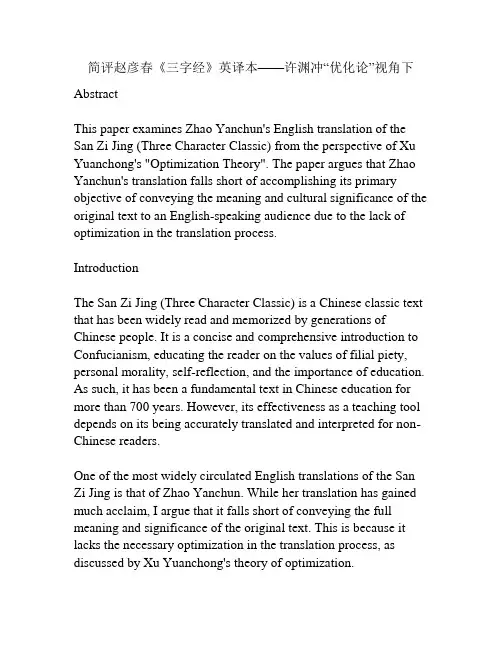
简评赵彦春《三字经》英译本——许渊冲“优化论”视角下AbstractThis paper examines Zhao Yanchun's English translation of the San Zi Jing (Three Character Classic) from the perspective of Xu Yuanchong's "Optimization Theory". The paper argues that Zhao Yanchun's translation falls short of accomplishing its primary objective of conveying the meaning and cultural significance of the original text to an English-speaking audience due to the lack of optimization in the translation process.IntroductionThe San Zi Jing (Three Character Classic) is a Chinese classic text that has been widely read and memorized by generations of Chinese people. It is a concise and comprehensive introduction to Confucianism, educating the reader on the values of filial piety, personal morality, self-reflection, and the importance of education. As such, it has been a fundamental text in Chinese education for more than 700 years. However, its effectiveness as a teaching tool depends on its being accurately translated and interpreted for non-Chinese readers.One of the most widely circulated English translations of the San Zi Jing is that of Zhao Yanchun. While her translation has gained much acclaim, I argue that it falls short of conveying the full meaning and significance of the original text. This is because it lacks the necessary optimization in the translation process, as discussed by Xu Yuanchong's theory of optimization.Xu Yuanchong's "Optimization Theory"Xu Yuanchong, an acclaimed translator himself, has put forward the "Optimization Theory" of translation. According to him, translation should be not just faithful, but also innovative, readable, and cultural. Xu argues that a translator should strive to optimize these four aspects to ensure that their translation accurately captures the intended original meaning and conveys this meaning to the target audience.Applying Xu Yuanchong's Optimization Theory to Zhao Yanchun's TranslationFaithfulnessZhao Yanchun's translation of the San Zi Jing is faithful to the original text. While her translation is not a line-by-line, word-for-word translation, it preserves the general meaning of the original text and its cultural significance. However, while faithfulness is a necessary condition for a good translation, it is not sufficient. A good translation should also be readable, innovative, and culturally relevant.ReadabilityZhao Yanchun's translation fails to optimize readability. While it is true that the San Zi Jing is concise, Zhao's translation makes the text look intimidating to an English-speaking audience. The text is presented without headings, subheadings, or chapter formatting, making it appear to be a large block of text. Because of this, thereader loses sight of the distinct division and hierarchical structure of the original text. Zhao Yanchun failed to optimize readability, which is important to the assimilation of the text by a non-Chinese audience.InnovationZhao Yanchun's translation fails to optimize innovation. Her translation of the San Zi Jing does not go beyond a one-to-one correspondence between the Chinese original and its English form. Because of this, there is a lack of innovation and creativity in the translation. The text remains rigidly frozen in the original syntax and grammar of the Chinese language. This makes it very difficult for the non-Chinese readers to understand the context and significance of the text. Zhao Yanchun has failed to optimize innovation, which is required to make the text accessible and understandable to a non-Chinese speaking audience.Cultural RelevanceZhao Yanchun's translation fails to optimize cultural relevance. Although she has conveyed the general meaning of the text, the cultural significance of the text has not been fully conveyed. The San Zi Jing is a text rooted in Confucianism, which is a profound and complex cultural tradition that is difficult to understand. The translator must therefore use a translation strategy that provides cross-culture edification, showing the relevance of the text in both the source and target cultures. The translator should optimize the cultural relevance of the text by contextualizing it and relating it to the target audience. However, Zhao Yanchun's translation does notmake the necessary effort to achieve this, resulting in the text lacking cultural relevance.ConclusionIn conclusion, Zhao Yanchun's translation of the San Zi Jing fails to optimize didactic effectiveness due to lack of optimization. The translation's readability, innovation, and cultural relevance lag behind what is necessary for a successful transfer of meaning. To bring the San Zi Jing to an English-speaking audience, a translation that is optimized in all four aspects of Xu Yuanchong's optimization theory needs to be produced. This will ensure the effectiveness of the text as a teaching tool.To optimize the didactic effectiveness of the San Zi Jing, the translator needs to take a more comprehensive approach and not just rely on faithfulness to the original text. The text is not only a reflection of Confucian values, but it also serves to educate readers on the importance of education and personal morality. As such, the translator needs to take into account the cultural context of the text and provide cultural relevance that is accessible to the target audience.To optimize readability, the translator could use subheadings, bullet points, and/or chapter formatting to visually break up the text and make it easier to follow. This will allow the reader to focus on the content and understand the hierarchy of the text, which is crucial to understanding the overall meaning and message of the text.To optimize innovation, the translator could use footnotes or other annotations to explain cultural references or provide additionalcontext that is not explicit in the text. This will help the non-Chinese reader to better appreciate the underlying cultural significance of the text. Additionally, the translator could use creative approaches such as adding metaphors or similes to the translation to provide a better understanding of the text's content.To optimize cultural relevance, the translator could provide a short introduction or prologue that gives the reader a brief overview of the Confucian tradition and its significance. This would provide the reader with the necessary background to understand the text's cultural significance. Additionally, the translator could provide commentary or analysis that relates the text to contemporary issues and societal values.In summary, optimizing the didactic effectiveness of the San Zi Jing requires a comprehensive approach that goes beyond faithfulness to the original text. An optimized translation will be easily readable, innovative, culturally relevant, and faithful to the original text. Such an approach would provide non-Chinese readers with a better understanding of the text's cultural significance and help them appreciate the relevance and applicability of the text to their own lives.。
《三字经》英译本比较———以《三字经》第一节为例穆纪首(新乡学院大学外语部,河南新乡453003)摘要:通过比较、分析马礼逊、裨治文、翟理斯、赵彦春等翻译家的《三字经》英译本,发现赵译本“三词格偶韵体”《三字经》是最好的英译本,它再现了原作的张力,重塑了经典。
赵译本《三字经》对典籍外译作出了重要贡献,对发出中国声音、传播中华文明、讲好中国故事意义重大。
关键词:《英韵三字经》;翻译;评析中图分类号:H315文献标识码:A文章编号:2095-7726(2019)07-0047-03《三字经》是南宋王应麟(1223—1296年)为教育本族子弟读书所作的三字韵文。
每三字一行,每四行一节。
《三字经》与《千字文》《百家姓》并称中国国学三大启蒙读物。
《三字经》取材典范,包括中国传统文化的人伦义理、文学地理、忠孝节义等,其核心思想包括“仁、义、诚、敬、孝”,具有独特的思想价值和文化魅力。
《三字经》读起来朗朗上口,熟读之能了解生活常识、传统国学、历史典故及做人做事的道理。
一、《三字经》英译简介南宋至今,许多传教士、汉学家、翻译家将《三字经》翻译为英文,推广海外。
翻译《三字经》的学者和英译本众多。
主要翻译家有马礼逊(Robert Morrison )、裨治文(Elijah Coleman Bridgman )、翟理斯(Herbert Allen Giles )、赵彦春等人。
据考证,马礼逊是英译《三字经》的第一人。
马礼逊(1782—1834年),英国人,于1807年来到广州,成为基督新教传教士。
此后长期任东印度公司中文译员,翻译了许多中国典籍,其译文集《中国春秋》包括《三字经》《中庸》《大学》《太上老君》《三教源流》等。
裨治文(1801—1861年),美国传教士。
他于1830年来到广州,师从马礼逊学习汉语。
1834年参与创立益智会,1836年参与创办马礼逊教育会,1838年开设博济医院,曾任林则徐、美国公使顾盛的译员,创办并主编《澳门月报》,晚年主要从事《新旧约全书》新译工作,1861年在上海去世。
简评赵彦春《三字经》英译本许渊冲提出的“优化论”在翻译领域享誉盛名,尤其是对诗歌翻译有举足轻重的指引作用。
《三字经》作为中华民族珍贵的文化遗产,是经典的诗经启蒙读物,包含中国传统文化的文学、历史、哲学、人伦义理等等众多方面,具有极高的宣传和研究价值。
自马礼逊英译《三字经》以来,其英译本林林总总。
但到目前为止,只有赵彦春的《三字经》英译本可被称为译本之经典。
据此,用许渊冲的“优化论”作为评价原则,在人伦、哲学、文学、历史四部分各取一节简析赵彦春《三字经》英译本的经典之处。
标签:《三字经》;优化论;中华典籍翻译1 引言《三字经》英译,为议事之至难,被评论家视为“天使不敢涉足的地方”。
《三字经》有三大突出特征:一、它是每行三字;二、它是韵体;三、它是经典。
这三个因素为评价译本是否合格的关键所在,如果译本没有满足这三大因素,那便是不能被称之为合格的译本,抑或是失败的译本。
而且译本不仅要具备原作的三大特征,还要再现原作所表现的内容及其文辞风格和文化内涵。
赵彦春的《三字经》英译本不仅具备了原作的三大特征,而且字字经得起推敲斟酌,在翻译历史典故中也均处理很得当,可称之为迄今为止最经典的《三字经》英译本。
2 许渊冲的“优化论”许渊冲曾说过:“理论来自实践,又要受到实践的检验。
实践是检验真理的唯一标准。
这是我提出‘创中国学派文学翻译理论的哲学基础”。
在取其精华,去其糟粕的原则上,许渊冲继承前人学说理论,又凭一己之力再次创造,提出了自称一派的翻译理论——“优化论”,用“美化之艺术,创优似竞赛”这十个字加以概括。
“美”是指“意美、音美、形美”,即译诗要尽量传达原诗的音形意;“化”即“等化、浅化、深化”;“之”即“知之、好之、乐之”;“艺术”即”翻译是门艺术,不是科学”;“创”即“文学翻译等于创作”;“优”即“翻译要发挥译文语言优势”;“似”即“意似、音似、形似”;“竞赛”即“翻译是两种语言的竞赛,文学翻译更是两种文化的竞赛”。
翻译美学视角下《三字经》两个英译本分析《三字经》是我国古代儿童启蒙读物,共一千多字,内容大都采用韵文,每三字一句,四句一组,主要囊括教育、历史、天文、地理、伦理道德等中华传统文化。
《三字经》文体形式整齐划一,极具韵律美感,文字言简意赅、生动形象,是内容和形式的高度艺术统一。
《三字经》英译本林林总总,但“如果不能再现《三字经》三字韵文的文体特征、文辞风格和文化内涵,那就不能算是成功的译作”(赵彦春,2014)。
就国内较好的译本而言,有王宝童《英译三字经千字文》和赵彦春《英韵三字经》。
本文拟在翻译美学视角下对这两个译本进行比较和分析。
二、翻译美学翻译美学理论是翻译研究的一种新兴理论,探讨翻译如何与美学联姻。
在方梦之主编的《译学辞典》中,翻译美学被界定为:“揭示译学的美学渊源,探讨美学对译学的特殊意义,用美学的观点来认识翻译的科学性和艺术性,并运用美学的基本原理,提出翻译不同文本的审美标准,分析、阐释和解决语际转换中的美学问题”(方梦之,2004)。
刘宓庆(1995)在著作《翻译美学导论》中构建起了翻译美学的基本框架。
他从审美符号集,即形式系统入手,从语音、文字、词语、句和段的不同审美层级着眼,讨论了审美客体的审美信息;他强调了非形式系统,即审美模糊集包括“情”与“志”,“意”与“象”的辩证关系。
“在文学翻译中,审美再现所要再现的,是原文的内容情志美、语言形式美、修辞模式美、音韵声律美和篇章结构美”(党争胜,2010)。
《三字经》以高度凝练的语言抒情言志,翻译过程中,需综合考虑语言、文化和艺术的因素。
就语言层面而言,好的译文应该显示出源语中的形式美;就文化层面而言,应保留原文中民族化的语言表达方式;就艺术层面而言,要准确传神地再造源语中内容与形式的统一关系。
以下就《三字经》的两个译本作比较,分析译文如何再现原文的美学价值。
三、《三字经》两个译本的比较(一)语音层面语音是美学表达的基本载体。
《三字经》蕴含极富美感的韵律和节奏,读起来琅琅上口,极易成诵。
赵彦春《英韵三字经》系列(二)Aged four years,Rong proffered pears.Bear in mindFraternally be kind.孔子的后人孔融年仅四岁就知道把梨让给哥哥吃。
这种谦让的态度和友爱兄长的美德,是每个人从小就应该知道的。
And in the Han Dynasty, Rong (Kong Rong), Confucius descendant, offered his pears to his elder brother although he was only four. Everyone should learn this kind of respect for affinity.shǒu xio t首孝悌,c jin wn次见闻,zhī mǒu sh知某数,sh mǒu wn识某文。
Stress piety moreThan your lore.Learn some numeracy,Know some literacy.孝敬父母、爱护兄弟是首要的,其次才是知识。
至于知识,大家要学点算术和语文。
Piety (loving parents and brothers) is more important than knowledge. As for knowledge, one should learn some numeracy and literacy.y r sh一而十,sh r bǎi十而百,bǎi r qiān百而千,qiān r wn千而万。
One to ten,A hundred then, One thousand more,Ten thousand afore.我国采用十进位数制:一到十是基本数字,然后依次为一百、一千、一万以此数制可以无穷地计算下去。
Decimalism is adopted in China: one to ten is primary, the next is one hundred, then one thousand, ten thousand, and so on. All computations can be done with this.sān ci zhě三才者,tiān d rn天地人。
《三字经》英文版《三字经》英文版人之初性本善性相近习相远Men at their birth,are naturally good.Their natures are much the same;their habits become widely different.苟不教性乃迁教之道贵以专If follishly there is no teaching,the nature will deteriorate.The right way in teaching,is to attach the utmost importancein thoroughness.昔孟母择邻处子不学断机杼Of old, the mother of Menciuschose a neighbourhoodand when her child would not learn,she broke the shuttle from the loom.窦燕山有义方教五子名俱扬Tou of the Swallow Hillshad the right methodHe taugh five son,each of whom raised the family reputation. 养不教父之过教不严师之惰To feed without teaching,is the fathers fault.To teach without severity,is the teachers laziness.子不学非所宜幼不学老何为If the child does not learn,this is not as it should be.If he does not learn while young,what will he be when old ?玉不琢不成器人不学不知义If j ade is not polished,it cannot become a thing of use.If a man does not learn,he cannot know his duty towards his neighbour. 为人子方少时亲师友习礼仪He who is the son of a man,when he is young,should attach himself to his teachers and friends; and practise ceremonial usages.香九龄能温席孝于亲所当执Hsiang, at nine years of age,could warm (his parents) bed.Filial piety towards parents,is that to which we should hold fast.融四岁能让梨弟于长宜先知Jung, at four years of age, Y)could yield the (bigger) pears.To hehave as a younger brother towards elders, is one of the first things to know.首孝弟次见闻知某数识某文Begin with filial piety and fraternal love,and then see and hear .Learn to count,and learn to read.一而十十而百百而千千而万units and tens,then tens and hundreds,hundreds and thousands,thousands and then tens of thousands.三才者天地人三光者日月星The three forces,are heaven, earth and man.The three luminaries,are the sun,the moon and the stars.三纲者君臣义父子亲夫妇顺The three bonds,are the obligation between soverign and subject, the love between father and child,the harmony between husband and wife.曰春夏曰秋冬此四时运不穷We speak of spring and summer,we speak of autumn and winter,These four seasons,revolve without ceasing.曰南北曰西东此四方应乎中We speak of North and South,we speak of East and West,These four points,respond to the requirements of the centre.曰火水木金土此五行本乎数We speak of water, fire,wood,metal and earth.These five elements,have their origin in number.曰仁义礼智信此五常不容紊We speak of chairty, of (??hear ??) and of duty towards one neighbour,(?? an error in my original copy. I cant figure out what it is.) of propriety, of wisdom, and of truth.These five virtues,admit of no compromise.稻粱菽麦黍稷此六谷人所食Rice , spike, millet, pulsewheat, glutinous millet and common millet,These six grains,are those which men eat.马牛羊鸡犬豕此六畜人所饲The horse, the ox, the sheep,the fowl, the dog, the pig.These six animals,are those which men keep.曰喜怒曰哀惧爱恶欲七情具We speak of joy, of anger,we speak of pity, of fear,of love , of hate and of desire.These are the seven passions.匏土革木石金? @与丝竹乃八音The gound, earthenware,skinwood, stone metal,silk and bamboo,yield the eight musical sounds.高曾祖父而身身而子子而孙Great great grandfather,great grandfather, grandfather,father and self,self and son,son and grandson,自子孙至玄曾乃九族人之伦from son and grandson,on to great grandson and great great grandson.These are the nine agnates,constituting the kinships of man.父子恩夫妇从兄则友弟则恭Affection between father and child,harmony between husband and wife,friendliness on the part of elder brothers,respectfulness on the part of younger brothers,长幼序友与朋君则敬臣则忠procedence(??) between elders and youngers, (probably : precedence )as between friend and friend.Respect on the part of the sovereign,loyalty on the part of the subject.此十义人所同These ten obligations,are common to all men.凡训蒙须讲究详训诂名句读In the education of the young,there should be explanation and eluciation,careful teaching of the interpretations of commentators,and due attention to paragraphs and sentences.为学者必有初小学终至四书Those who are learners,must have a beginning.The little learning finished,& nbsp; they proceed to the four books.论语者二十篇群弟子记善言There is the Lun Yu (discourse or Analects),in twenty sections.In this, the various disciples,have recorded the wise sayings of Confucious.孟子者七篇止讲道德说仁义The works of Mencius,have comprised in seven section.These explain the way and exemplifications thereof,and expound clarity and duty towards ones neighbour.作中庸子思笔中不偏庸不易The Chung Yung (the doctrine of the mean),by the pen of Tzu-su;Chung (the middle) being that which odes not lean towards any side,Yung( the course) being that which cannot be changed.作大学乃曾子自修齐至平治He who wrote the Great Learningwas the philosopher Tseng.Beginning with cultivation of the individual and ordering of the family,It goes on to government of ones own State and ordering of the family.孝经通四书熟如六经始可读When the Classic of Filial Piety is mastered,and the Four books are known by heart.The next step is to the Six classics,which may now be studied.诗书易礼春秋号六经当讲求The Books of Poetry, of History and of Changes.The Rites of Chou Dynasty, the book of Tites, and the Spring and AutumAnnalsare the six classicswhich should be carefully explained and analysed.有连山有归藏有周易三易详There is the Lien Shan System,there is the Kuei TsangAnd there is the system of Changes of the Chou Dynasty,such are the 3 systems which elucidate the changes.有典谟有训诰有誓命书之奥There are the Regulations and the Counsels,The Instruction, The Annoucements,The Oaths, The Charges,These are the profundities of the Book of History.我周公作周礼着六官存治体Our Duke of Chou,drew up the Ritual of the Chou Dynasty,in which he set forth the duties of the six classes of officials;and thus gave a settled form to the government.大小戴注礼记述圣言礼乐备The Elder and the Younger Tai,wrote commentaries on the Book of Rites.They publish the holy words,and Ceremonies and Music were set in order.曰国风曰雅颂号四诗当讽咏We speak of the Kuo Feng,we speak of the Ya and the Sung.These are the four sections of the Book of poetry,which should be hummed over and over.诗既亡春秋作寓褒贬别善恶When odes ceased to be made,the Spring and Autumn Annals were produced.These Annals contain praise and blame,and distinguish the good from the bad.三传者有公羊有左氏有彀梁The three commentaries upon the above,include that of Kung-Yang,th at of Tsoand that of Ku-Liang.经既明方读子撮其要记其事When the classics were understood,then the writings of the various philosophers should be read.Pick out the important points in each,and take a note of the facts.五子者有荀杨文中子及老庄The five chielf phlosophers,are Haun, Yang,Wen Chung TzuLao Tzu and Chung Tzu.经子通读诸史考世系知终始When the classics and the philosophers are mastered,the various histories should then be read,and the genealogical connections should be examined,so that the end of one dynasty and the beginning of the next be known.自羲农至黄帝号三皇居上世From Fu Hsi and Shen Nung.(??on ?? probably to or onto ) the Yellow Emperor,these are called the three rulers.who lived in the early ages.唐有虞号二帝相揖逊称盛世Tang and Yu-Yuare called the two emperors.They adbicated, one after the other,and their was called the Golden Age.夏有禹商有汤周文武称三王The Hsia dynasty has Yuand the Shang dynasty has TangThe Chou dynasty had Wen and Wu;these are called the Three Kings夏传子家天下四百载迁夏社Under the Hsia dynasty the throne was transmitted from father to son,making a family possession of the empire.A fter four hundred years,the imperial sacrifice passed from the house of Hsia.汤伐夏国号商六百载至纣亡Tang the completer destroyed the Hsia Dynasty,and the Dynastic title became Shang.The line lasted for six hundred years,ending with Chou Hsin.周武王始诛纣八百载最长久King Wu of the Chou Dynastyfinally slew Chou Hsin.His own line lasted for eight hundred years;the longest dynasty of all.周辙东王纲堕逞干戈尚游说When the Chous made tracks eastwards,the feudal bond was slackened;the arbitrament of spear and shields prevailed;and peripatetic politicians were held in high esteem.始春秋终战国五霸强七雄出This period began with the Spring and Autum Epochand ended with that of the Warring States.Next, the Five Chieftains domineered,and Seven Martial States came to the front.嬴秦氏始兼并传二世楚汉争Then the House of Chin, descended from the Ying clan,finally united all the states under one sway.The thrown was transmitted to Erh Shih,upon which followed the struggle between the Chu and the Han states.高祖兴汉业建至孝平王莽篡Then Kao Tsu arose,and the House of Han was established.When we come to the reign of Hsiao Ping,Wang Mang usurped the throne.光武兴为东汉四百年终于献Then K uang Wu arose,and founded the Eastern Han Dynasty.It lasted four hundred years,and ended with the Emperor Hsien.魏蜀吴争汉鼎号三国迄两晋Wei, Shu and Wu,fought for the sovereignty of the Hans.They were called the Three Kingdoms,and existed until the two Chin Dynasties.宋齐继梁陈承为南朝都金陵Then followed the Sung and the Chi dynasties,and after them the Liang and Chen dynastiesThese are the Southen dynasties,with their capital at Nanking.北元魏分东西宇文周兴高齐The northern dynasties are the Wei dynasty and the Yuan familywhich split into Eastern and Western Wei.The Chou dynasty and the Yuwen family,with the Chi dynasty of the Kao family.迨至隋一土宇不再传失统绪At length, under the Sui dynasty,the empire was united under one ruler.The throne was not transmitted twice,succession to power being loast唐高祖起义师除隋乱创国基The first emperor of the Tang dynastyraised volunteer troops.He put an end to the disorder of the House of Sui,and established the foundation of his line.二十传三百载梁灭之国乃改Twenty times the thrown was transmitted,in a period of 300 years.The Liang State destroyed it,and the dynastic title was changed.梁唐晋及汉周称五代 ? 狾野?BR> The Liang, the Tang, the Chin the Han and the Chouare called the five dynasties,and there was a reason for the establishment of each.炎宋兴受周禅十八传南北混Then the fire-led house of Sung arose,and received the resignation of the house of Chou. Eighteen times the throne was transmitted,and then the north and the south were reunited.辽与金皆称帝此段为宋版所无太祖兴国大明号洪武都金陵此段为宋版所无迨成祖迁燕京十六世至崇祯此段为宋版所无阉乱后寇内讧闯逆变神器终此段为宋版所无清顺治据神京至十传宣统逊此段为宋版所无举总统共和成复汉土民国兴此段为宋版所无廿二史全在兹载治乱知兴衰此段为宋版所无十七史全在兹载治乱知兴衰The Seventeen Dynastic Histories,are all embraced in the above.They contain examples of good and bad government, whence may be learnt the principles of prosperity and decay. 读史书考实录通古今若亲目Ye who read historymust study the Annals,whereby you will understand ancient and modern events, as though having seen them with your own eyes.口而诵心而惟朝于斯夕于斯Recite them with the mouth,and ponder over them in your hearts.Do this in the morning;do this in the evening.昔仲尼师项橐古圣贤尚勤学Of old, Confucius,took Hsiang To for his teacher.The inspired men and sages of old,studied diligently nevertheless.赵中令读鲁论彼既仕学且勤Chao, president of the Council,studied the Lu Test of the Analects.He, when already an official,studied and moreover, with diligence.披蒲编削竹简彼无书且知勉One opened out rushes and plaited them together, another scraped tablets of bamboo.These men had no books,but they knew how to make an effort.头悬梁锥刺股彼不教自勤苦One tied his head to the beam above him;another pricked his thigh with an awl.They were not taught,but toiled hard of their own accord.如囊萤如映雪家虽贫学不辍Then we have one who put fireflies in a bag.and again another who used the white glare from snow. Although their families were poor,these men studied uncessingly.如负薪如挂角身虽劳犹苦卓Again, there was one who carried fuel,and another who used horns and pegs.Although they toiled with their bodies,they were nevertheless remarkable for their application. 苏老泉二十七始发愤读书籍Shu Lao-Chuan,at the age of twenty-sevenat last began to show his energy,and devote himself to the study of books.彼既老犹悔迟尔小生宜早思Then when already past the age,he deeply regretted his delay.You little boys,should take thought betimes. (?? betimesnot sure !) 若梁灏八十二对大廷魁多士Then there were Liang Hao,who at the age of eighty-two,made his replies to the great hall,and came out first among many scholars.彼既成众称异尔小生宜立志When thus late he had succeeded,all men pronounced him a prodigy.You little boys,should make up your minds to work.莹八岁能咏诗泌七岁能赋棋Jung at eight of age,could compose poetry.Pi, at seven years of age,could make an epigram on wei-ch.i彼颖悟人称奇尔幼学当效之These youths were quick of apprehension,and people declared them to be prodigies.You young learners,ought to imitate them.蔡文姬能辨琴谢道韫能咏吟Tsai Wen-chi,was able to judge from the sound of a psaltery. Hsieh Tao-yun,was able to compose verses.彼女子且聪敏尔男子当自警They were only girls,yet they were quick and clever.You boys ought torouse yourselves.唐刘晏方七岁举神童作正字Liu Yen of the Tang dynasty& nbsp; when only seven years of age,was ranked as an inspired child (child prodigy) and was appointed a Corrector of Texts.彼虽幼身己仕尔幼学勉而致He, although a child,was already in an official post.You young learnersstrive to bring about a like result.有为者亦若是Those who work,will also succeed as he did.犬守夜鸡司晨苟不学曷为人The dog keep guard by night;the cock proclaims the dawn.If foolishly you do not study,how can you become men ?蚕吐丝蜂酿蜜人不学不如物The silkworm produced silk,the bee makes honey.If man does not learn,he is not equal to the brutes幼而学壮而行上致君下泽民Learn while young,and when grown up apply what you have learn; influencing the soverign above,benefitting the people below.扬名声显父母光于前裕于后Make a name for yourselves,and glority you father and mother.shed lustre on your ancestors,enrich your posterity.人遗子金满嬴我教子惟一经Men bequeath to their children,coffers of gold.I teach you children,only this book.勤有功戏无益戒之哉宜勉力Diligence has its reward;play has no advantages,& nbsp;Oh, be on your guard,and put forth your strength.。
赵彦春英译《易传系辞下》赵彦春英译《易传系辞下》子曰:乾坤,其《易》之门邪?乾,阳物也;坤,阴物也。
阴阳合德,而刚柔有体,以体天地之撰,以通神明之德。
其称名也,杂而不越。
于稽其类,其衰世之意邪?夫《易》,彰往而察来,而微显阐幽,开而当名,辨物正言断辞,则备矣。
其称名也小,其取类也大。
其旨远,其辞文,其言曲而中,其事肆而隐。
因贰以济民行,以明失得之报。
Companion to Changes Appendix TwoConfucius said: Arent Gen and Kueen two doors to Change? Gen is Shine, and Kueen Shade. The virtuous mating of Shine and Shade makes things properly hard or soft to reveal the writings of Heaven and earth and to reach the virtue of divinity. Though names are various, there are no transgressions. Doesnt an examination of their kinds show symbols in declining order? Change illuminates the past, predicts the future and illustrates what is tiny and hidden. Open it, and we see proper names that distinguish all things, make sound judgments and correct predictions, so perfect! The names though little refer to large kinds and express great purports elegantly; the words, though insinuative, hit the target; the things, though expressed, are obscure. It serves the peop le in forms of auxiliaries and enlightens the retribution of losses and gains.。
三字经英韵(前)汉英对照·注解·完整版人之初,性本善。
性相近,习相远。
Man on earth,Good at birth.The same natureVaries on nurture.人在太初或刚出生时其本性都是善良的;由于后天成长环境、教育背景不一样,性情也就有了各种各样的差别。
Man was good in the beginning,or he is good at birth.Human nature deviates due to different nurtures.苟不教,性乃迁。
教之道,贵以专。
With no education,There'd be aberration.To teach well,You deeply dwell.对孩子如果不进行适当的教育,其本性就会发生变化。
说到教育,最关键的问题就是要专心一致,精讲要义而不厌其烦。
If a child is not properly taught,he may go astray.In education,what is important is to be focus ed,dwelling on key points.昔孟母,择邻处,子不学,断机杼。
Then Mencius'motherChose her neighbor.At Mencius sloth,She cut th' cloth.战国时期,孟子的母亲为了使孟子有个良好的学习环境曾经三次搬家。
有一次孟子逃学,孟母就割断织机的布来表明事情的严重性和中断学习的后果。
In the Warring State period,Mencius'mother moved three times for better environment for her son.Mencius once played truant,and she cut the cloth she was weaving to show her seriousnes s and the consequences of interrupted learning.窦燕山,有义方,教五子,名俱扬。
Dough by nameFulfilled his aim.His five sonsBecame famous ones.五代十国时期,有个燕山人,名叫窦禹钧。
他创办私塾,延聘名师,教子有方。
他的五个儿子都科举成名,很有成就。
In the Five Dynasties and Ten Kingdoms period,there was a man,Dough by name,from the Sw allow Hills.He founded a private school,hired famous teachers,and managed well in having his c hildren taught.All his five sons passed Grand Test or the Imperial Examinations as it is often calle d,and lived very successful lives.养不教,父之过。
教不严,师之惰。
What's a father?A good teacher.What's a teacher?A strict preacher.养育儿女,仅仅供其吃穿,而不进行良好的教育,那便是做父亲的过错。
教育为本,但是只教育,而不严格要求那就是做老师的没有尽到职责了。
It is not enough to provide children with food and cation is important.To rear childr en without giving them good education is a father’s fault;a teacher is considered lazy if he is not strict with the children he teaches.子不学,非所宜。
幼不学,老何为?An unschooled childWill grow wild.A young loafer,An old loser!小孩子应该好好学习。
一个人小时候如果不好好学习,到老的时候能有什么用呢?A child should have proper education.If one does not do well,what will become of him when h e is grown up?玉不琢,不成器。
人不学,不知义。
No jade crude,Shows craft good.Unless you learn,Brute you'll turn.璞玉不经打磨,便不会成为精美的艺术品;人要是不学习,就不懂得人情礼节,也就不能有用之才。
If jade is not honed and carved,it will not be a fine piece of art;if one doesnot receive education,he will not be a gentleman,and will not be something.为人子,方少时,亲师友,习礼仪。
Son of man,Mature you can.Teacher or peer,Hold them dear.作为儿女,或如人子,终会长大成人。
在成长过程中应学会亲近师友,当心存感激,不要轻慢无礼,要学一些为人处事的礼节。
As children,you will grow up like Son of Man .While young,you should approach and requite your models like teachers and friends,and l earn good manners from them.香九龄,能温席。
孝于亲,所当执。
Hsiang,at nine,Warmed bedding fine,Follow this one,This filial son.东汉时,有个叫黄香的,九岁时就懂得孝顺父母,比如他冬天给父亲暖热被窝。
这种行为是每个孝顺父母的人都应该实行和效仿的。
A boy named Hsiang(Huang Hsiang)in the Eastern Han Dynasty knew how to show kindness to his parents at n ine.He warmed bedding for his father in winter.One should do like this,to be a filial son.融四岁,能让梨。
弟于长,宜先知。
Aged four years,Rong proffered pears.Bear in mindFraternally be kind.汉代时,孔子的后人孔融年仅四岁就知道把梨让给哥哥吃。
这种尊敬和友爱兄长的道理,是每个人从小就应该知道的。
And in the Han Dynasty,Rong(Kong Rong),Confuius' descendant,offered his pears to his brother although he was only four.Everyone should learn thi s kind of respect for affinity.首孝悌,次见闻,知某数,识某文。
Stress piety moreThan your lore.Learn some numeracy,Know some literacy.孝敬父母、爱护兄弟是首要的,其次才是知识。
至于知识,大家要学点算术和语文。
Piety (loving parents and brothers)is more important than knowledge.As for knowledge,one should learn some numeracy and literacy.一而十,十而百,百而千,千而万。
One to ten,A hundred then,One thousand more,Ten thousand afore.我国采用十进位数制:一到十是基本数字,然后依次为一百、一千、一万……以此数制可以无穷地计算下去。
Decimalism is adopted in China:one to ten is primary,next is one hundred,then one thousand,t en thousand,and so on. All computations can be done with this.三才者,天地人。
三光者,日月星。
Tri-vitals,of worth:Man,heaven,earth;Tri-lights,a boon:Sun,stars,moon.大家还应该具备一些基本的知识,比如什么叫三才?三才指的是天、地、人三个元素。
什么叫三光呢?三光就是太阳、月亮、星星。
And one should know some rudiments,such as what we call tri-vitals,or three elements, that is, Heaven,Earth,Man,and what we call tri-lights or three luminaries,that is, Sun,Moon and Stars.三纲者,君臣义父子亲,夫妇顺。
Three tenets always:Subject Lord obeys;Child Father reveres;Wife Man endears.人与人之间关系应该遵守的三个行为准则是什么呢?就是君王与臣子之间要合乎义理,父母子女之间要相亲相爱,夫妻之间要和和美美。
What are the three tenets one should always follow?The king or emperor should be obeyed by hi s subjects,the father should be revered by his children,and the man endeared by his wife.曰春夏,曰秋冬,此四时,运不穷。